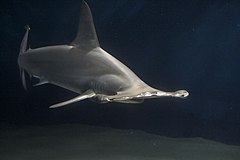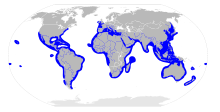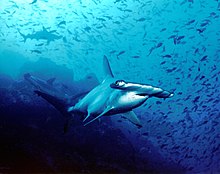Hammerhead shark
| Hammerhead sharks Temporal range:
| |
|---|---|

| |
| Scalloped hammerhead, Sphyrna lewini | |
| Scientific classification | |
| Kingdom: | |
| Phylum: | |
| Class: | |
| Subclass: | |
| Order: | |
| Family: | Sphyrnidae T. N. Gill, 1872
|
| Genera | |
| |

| |
The hammerhead sharks are a group of sharks in the family Sphyrnidae, so named for the unusual and distinctive structure of their heads, which are flattened and laterally extended into a "hammer" shape called a "cephalofoil". Most hammerhead species are placed in the genus Sphyrna while the winghead shark is placed in its own genus, Eusphyra. Many not necessarily mutually exclusive functions have been proposed for the cephalofoil, including sensory reception, maneuvering, and prey manipulation. Hammerheads are found worldwide in warmer waters along coastlines and continental shelves. Unlike most sharks, hammerheads usually swim in schools during the day, becoming solitary hunters at night. Some of these schools can be found near Malpelo Island in Colombia, Cocos Island off Costa Rica, and near Molokai Island in Hawaii. Large schools are also seen in southern and eastern Africa.
Description
The nine known species range from 0.9 to 6 m (3.0 to 19.7 ft) long and weigh from 3 to 580 kg (6.6 to 1,278.7 lb).[2][3] Although several hammerhead species are quite large, these are more slender and streamlined compared to other large sharks, which undoubtedly increase their speed and manuverability in the water.[4] They are usually light gray and have a greenish tint to them. Their bellies are white which allows them to be close to the bottom of the ocean and blend in to sneak up on their prey.[5] Their heads have lateral projections which give them a hammer-like shape.

It was determined recently that the hammer-like shape of the head may have evolved (at least in part) to enhance the animal's vision.[6] The positioning of the eyes, mounted on the sides of the shark's distinctive hammer head give the shark good 360-degree vision in the vertical plane, meaning they can see above and below them at all times.[7] The shape of the head was previously thought to help the shark find food, aiding in close-quarters maneuverability and allowing sharp turning movement without losing stability. However, it has been found that the unusual structure of its vertebrae was instrumental in making the turns correctly, more often than the shape of its head, though it would also shift and provide lift. From what is known about the Winghead shark, it would appear that the shape of the hammer-head has to do with an evolved sensory function. Like all sharks, hammerheads have electroreceptory sensory pores called ampullae of Lorenzini. By distributing the receptors over a wider area, hammerheads can sweep for prey more effectively.[8]
Hammerheads have disproportionately small mouths and seem to do a lot of bottom-hunting. They are also known to form schools during the day, sometimes in groups of over 100. In the evening, like other sharks, they become solitary hunters.
Taxonomy
Since sharks do not have mineralized bones and rarely fossilize, it is their teeth alone that are commonly found as fossils. The hammerheads seem closely related to the carcharhinid sharks. The teeth of hammerheads resemble those of some carcharhinid. Using mitochondrial DNA, Andrew Martin constructed a phylogenetic tree of the hammerhead sharks that showed the winghead shark as its most basal member. As the winghead shark has proportionately the largest "hammer" of the hammerhead sharks, this suggests that the first ancestral hammerhead sharks also had large hammers.[9]
Reproduction
Reproduction only occurs once a year for hammerhead sharks and usually occurs with the male shark biting the female shark violently until she agrees to mate with him.[10] The hammerhead sharks exhibit a viviparous mode of reproduction with females giving birth to live young. Like other sharks, fertilization is internal with the male transferring sperm to the female through one of two intromittent organs called claspers. The developing embryos are at first sustained by a yolk sac. When the supply of yolk is exhausted, the depleted yolk sac transforms into a structure analogous to a mammalian placenta (called a "yolk sac placenta" or "pseudoplacenta"), through which the mother delivers sustenance until birth. Once the baby sharks are born, they are not taken care of by the parents in any way. There is usually a litter of 12 to 15 pups; except for the Great Hammerhead which births litters of 20 to 40 pups. These baby sharks huddle together and swim toward warmer water and stay together until they are older and big enough to be on their own.[10]
In 2007, the bonnethead shark was found to be capable of asexual reproduction via automictic parthenogenesis, in which a female's ovum fuses with a polar body to form a zygote without the need for a male. This was the first shark known to do this.[11]
Diet
Hammerhead sharks are known to eat a large range of items including fish, squid, octopus, crustaceans, and other hammerhead sharks. Stingrays are a particular favorite. These sharks are found many times swimming along the bottom of the ocean, stalking their prey. Their unique head is used as a weapon when hunting down prey. The hammerhead shark uses its head to pin down stingrays and eats the ray when the ray is weak and in shock.[12] There is a species of the hammerhead shark that is more aggressive and large in size: the Great Hammerhead. These sharks tend to be more aggressive and eat squid and octopus and can be cannibalistic, that is to say, they have been known to eat other hammerhead sharks. They are also known to eat their own young.[13]
Species


- Genus Eusphyra T. N. Gill, 1862
- Eusphyra blochii (Cuvier, 1817) (Winghead shark)
- Genus Sphyrna Rafinesque, 1810
- Sphyrna corona S. Springer, 1940 (Scalloped bonnethead)
- Sphyrna lewini (E. Griffith & C. H. Smith, 1834) (Scalloped hammerhead)
- Sphyrna media S. Springer, 1940 (Scoophead)
- Sphyrna mokarran (Rüppell, 1837) (Great hammerhead)
- Sphyrna tiburo (Linnaeus, 1758) (Bonnethead)
- Sphyrna tudes (Valenciennes, 1822) (Smalleye hammerhead)
- Sphyrna zygaena (Linnaeus, 1758) (Smooth hammerhead)
Announcements in June, 2006 reported the discovery of a possible new species of hammerhead off the shores of South Carolina. The possible new species is referred to simply as a cryptic species until it receives an official designation. This is prolonged, in part, because the discovery is really that the "scalloped hammerhead" is possibly two different species, not that a new species has been sighted, in the normal way. The discovery that scalloped hammerheads are possibly two species is a result of genetic testing and counts of vertebrae.[14][15]
Relationship to humans

Of the nine known species of hammerhead, three can be dangerous to humans: the scalloped, great, and smooth hammerheads.
The great and the scalloped hammerhead are listed on the World Conservation Union's (IUCN) 2008 Red List as endangered, whereas the smalleye hammerhead is listed as vulnerable. The status given to these sharks is as a result of over-fishing and demand for their fins, an expensive delicacy. Among others, scientists expressed their concern about the plight of the scalloped hammerhead at the American Association for the Advancement of Science annual meeting in Boston. The young swim mostly in shallow waters along shores all over the world to avoid predators.
Shark fins are prized as a delicacy, and overfishing is putting many hammerhead sharks at risk of extinction. Fishermen who harvest the animals typically cut off the fins and toss the remainder of the fish, which is often still alive, back into the sea.[16] As of 2010 there have been 33 attacks, but no fatalities.
Hawaiian culture
In Native Hawaiian culture, sharks are considered to be gods of the sea, also known as aumakua, protectors of humans, and cleaners of excessive ocean life. Some of these sharks are believed to be family members who died and have been reincarnated into shark form. However, there are sharks that are considered man-eaters, also known as niuhi. These sharks include great white sharks, tiger sharks, and bull sharks. The hammerhead shark, also known as mano kihikihi, is not considered a man-eater or niuhi; it is considered to be one of the most respected sharks of the ocean, an aumakua. Many Hawaiian families believe that they have an aumakua watching over them and protecting them from the niuhi. The hammerhead shark is thought to be the birth animal of some children. Hawaiian children who are born with the hammerhead shark as an animal sign are believed to be warriors and are meant to sail the oceans. It is extremely rare for hammerhead sharks to pass through the waters of Maui, but many Maui natives believe that when the hammerhead sharks pass by, it is a sign that the gods are watching over the families, and the oceans are clean and balanced.[17]
See also
References
- ^ Sepkoski, Jack (2002). "A compendium of fossil marine animal genera (Chondrichthyes entry)". Bulletins of American Paleontology. 364: 560. Retrieved 01/09/08.
{{cite journal}}: Check date values in:|accessdate=(help) - ^ [1]
- ^ "Record Hammerhead Pregnant With 55 Pups". Discovery News. Associated Press. July 1, 2006. Retrieved October 18, 2008.
{{cite news}}: Cite has empty unknown parameter:|coauthors=(help) - ^ Castro, José I., The Sharks of North America. Oxford University Press (2011), ISBN 978-0-19-539294-4
- ^ - Hammerhead Shark: Shark-World
- ^ |McComb et al.|
- ^ D. Michelle McComb; et al. (2009-11-27). "Hammerhead shark mystery solved". BBC News. Retrieved 2010-05-04.
{{cite news}}: Explicit use of et al. in:|author=(help) - ^ R. Aidan Martin. "If I Had a Hammer". Rodale's Scuba Diving August 1993. Retrieved March 2006.
{{cite web}}: Check date values in:|accessdate=(help) - ^ R. Aidan Martin. "Origin and Evolution of the 'Hammer'". www.elasmo-research.org. Retrieved January 2005.
{{cite web}}: Check date values in:|accessdate=(help) - ^ a b - HAMMERHEAD SHARK: Aquatic Community
- ^ Chapman, DD (2007-08-22). "Virgin birth in a hammerhead shark". Biology Letters. 3 (4). doi:10.1098/rsbl.2007.0189. PMC 2390672. PMID 17519185.
{{cite journal}}: Unknown parameter|coauthors=ignored (|author=suggested) (help) - ^ HAMMERHEAD SHARK - Aquatic Community
- ^ HAMMERHEAD SHARK - Enchanted Learning Software
- ^ Quattro; et al. (December 2005). "Genetic evidence of cryptic speciation within hammerhead sharks (Genus Sphyrna)". Marine biology. 148 (5). Springer Berlin / Heidelberg: 1143–1155. doi:10.1007/s00227-005-0151-x.
{{cite journal}}:|access-date=requires|url=(help); Explicit use of et al. in:|last=(help) - ^ "Scientist Finds 'Genetically Distinct' Shark". PhysOrg.com. Retrieved June 2006.
{{cite web}}: Check date values in:|accessdate=(help) - ^ http://www.washingtonpost.com/wp-dyn/content/article/2011/02/25/AR2011022505123.html Retrieval February 25, 2011
- ^ - Sharks Highly respected in Hawaiian Culture
- Froese, Rainer, and Daniel Pauly, eds. (2011). "Sphyrnidae" in FishBase. February 2011 version.
External links
- Animal Diversity Web Genus Sphyrna with species sub-pages
- Hammerhead Shark! web directory, with pictures
- Hammerhead Shark Facts fact sheet, general info, shark diving info
- Scaloped Hammerhead Shark Fact Sheet Scalloped Hammerhead Shark Fact Sheet
- HammerheadShark.org Information and more on the Hammerhead Shark
- "Electroreception in juvenile scalloped hammerhead and sandbar sharks" by Stephen M. Kajiura and Kim N. Holland, The Journal of Experimental Biology (2002). Attempts to explain the "hammer" shape.
- MarineBio: Great hammerhead shark, Sphyrna mokarran
- BBC News announcement of new Hammerhead species
- BBC Earth News announcement on why Hammerhead species have unusual head shape
